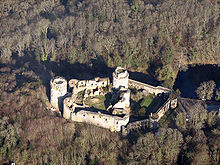- Château de Tonquédec
-
The Château de Tonquédec is a castle in Brittany, France, and one of the most visited monuments in the département of the Côtes d'Armor.
One of the most impressive French medieval sites, this château-fort, stands in a pleasant green forested countryside about 8.5 km (5.3 mi) south of Lannion. The present castle was built in the 15th century, on the site of an earlier 12th century castle[1].
Contents
History
From the height of a rocky cliff, the castle ruins, with its eleven towers and a closed curtain wall, dominates the valley of the Léguer. It is a genuine vestige of feudal Brittany.
The 12th century castle was the work of the Coëtmen-Penthièvre family. It was partially dismantled by order of Jean IV, Duke of Brittany, in 1395 because of a conflict between him and the Penthièvres. Indeed, Rolland II and Rolland III of Coëtmen, Viscounts of Tonquédec, had allied themselves to the rebellion of Olivier de Clisson.
Reconstruction began in 1406 by Rolland IV of Coëtmen. The castle subsequently changed owners several times, before becoming an artillery base in 1577. At this time, the owning family (Goyon de La Moussaye), being Protestant, was therefore in disagreement with the king, Henri IV. During the War of the League, the castle was a hiding place for Huguenots. It was finally dismantled around 1622 on the orders of the powerful Cardinal Richelieu.
The castle currently belongs to descendants of the original builders (House of Coëtmen-Penthièvre): Count and Countess Bertrand de Rougé. Since 1862, it has been listed as a monument historique by the French Ministry of Culture.
Visiting the castle
The entrance gate leads to an outer fortified courtyard or basse-cour. Two towers, joined by a curtain wall, frame the entrance to the inner courtyard which is reached by a postern, once protected by a moat and drawbridge. The keep with walls 4 m (13 ft) thick, stands detached from the curtain walls, at the rear of the ensemble. The view from the top gives a good idea of the local countryside: "a wide, fertile and populous plateau is intersected by deep and wooded picturesque valleys."[2]
The ruins may be visited from April to October. They may be hired for location filming, photo shoots and other events.
See also
External links
- Ministry of Culture database entry for Château de Tonquédec (French)
- Ministry of Culture photos
- Le Château de Tonquédec (French)
- Video about the Castle
References
- ^ Le Château de Tonquédec, Comte Aymeric de Rougé, Editions d'Art Jack, collection "Tout savoir", 2011.
- ^ Green Guide:Brittany. Michelin Tyre Co Ltd. 1974. p. 117. ISBN 2 06 101 151-9.
- This article incorporates information from this version of the equivalent article on the French Wikipedia.
Categories:- Buildings and structures in Côtes-d'Armor
- Châteaux in France
Wikimedia Foundation. 2010.

